coolant RENAULT KANGOO 1998 KC / 1.G Heating And Ventilation User Guide
[x] Cancel search | Manufacturer: RENAULT, Model Year: 1998, Model line: KANGOO, Model: RENAULT KANGOO 1998 KC / 1.GPages: 73
Page 47 of 73
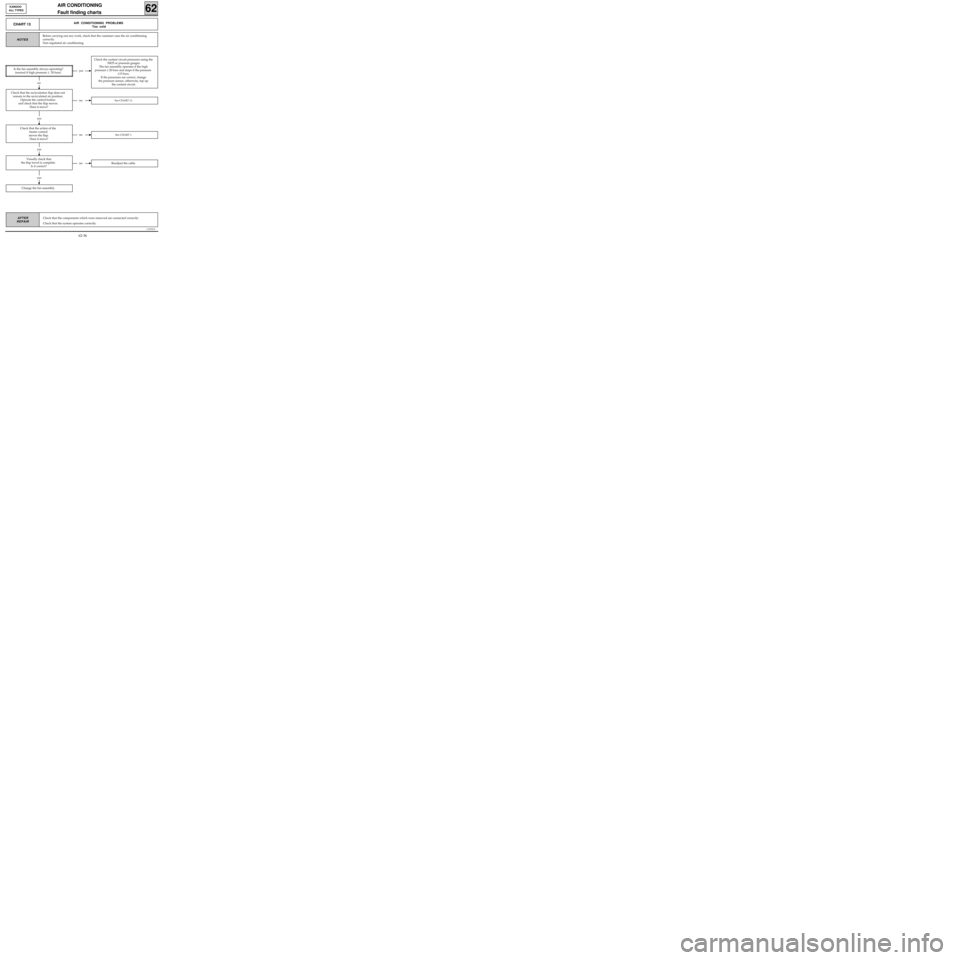
c11010.0
AIR CONDITIONING
Fault finding charts
62
KANGOO
ALL TYPES
AFTER
REPAIR
CHART 13AIR CONDITIONING PROBLEMS
Too cold
NOTES
yes
no
noSee CHART 11.
yes
noSee CHART 1.
yes
noReadjust the cable.
yes
Change the fan assembly.
Before carrying out any work, check that the customer uses the air conditioning
correctly.
Non regulated air conditioning.
Is the fan assembly always operating?
(normal if high pressure ≥ 20 bars)
Check that the recirculation flap does not
remain in the recirculated air position.
Operate the control button
and check that the flap moves.
Does it move?
Check that the action of the
heater control
moves the flap.
Does it move?
Visually check that
the flap travel is complete.
Is it correct?
Check the coolant circuit pressures using the
XR25 or pressure gauges.
The fan assembly operates if the high
pressure ≥ 20 bars and stops if the pressure
≤15 bars.
If the pressures are correct, change
the pressure sensor, otherwise, top up
the coolant circuit.
Check that the components which were removed are connected correctly.
Check that the system operates correctly.
62-36
Page 49 of 73
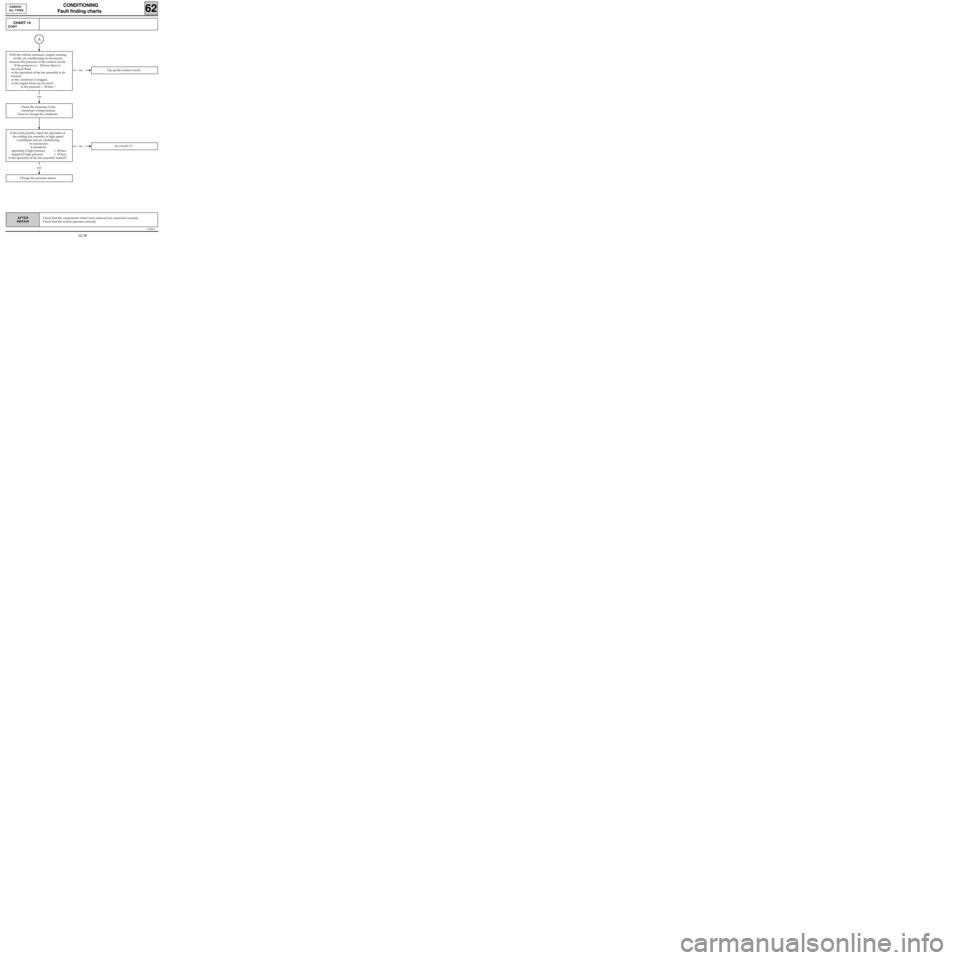
yes
c11010.0
CONDITIONING
Fault finding charts
62
KANGOO
ALL TYPES
AFTER
REPAIR
CHART 14
CONT
noTop up the coolant circuit.
yes
noSee CHART 15.
Change the pressure sensor.
Check the cleanness of the
condenser wiring harness.
Clean or change the condenser.
If the fault persists, check the operation of
the cooling fan assembly at high speed
(ventilation and air conditioning
on maximum).
It should be:
- operating if high pressure≥ 20 bars
- stopped if high pressure≤ 15 bars
Is the operation of the fan assembly normal?
Check that the components which were removed are connected correctly.
Check that the system operates correctly.
A
With the vehicle stationary, engine running
at idle, air conditioning on maximum,
measure the pressure of the coolant circuit.
If the pressure is > 28 bars, there is :
- too much fluid,
- or the operation of the fan assembly is ab-
normal,
- or the condenser is clogged,
- or the engine heats up too much.
Is the pressure < 28 bars ?
62-38
Page 50 of 73
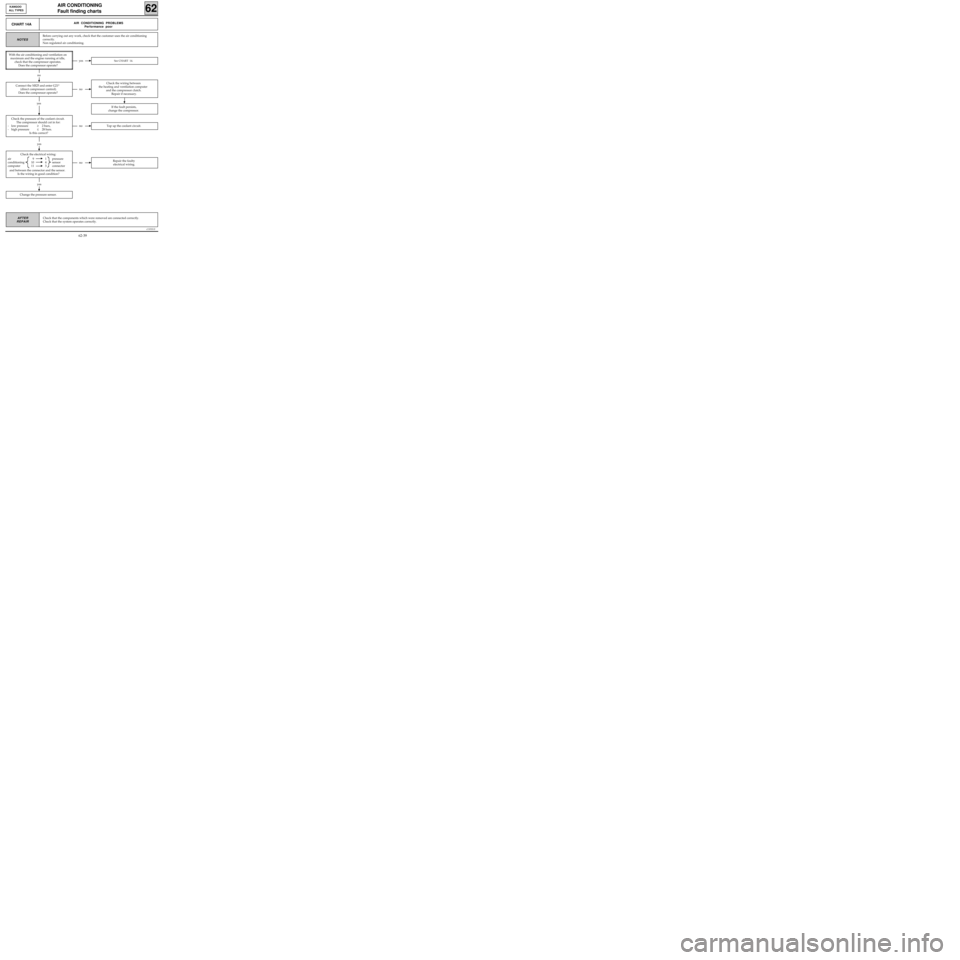
yes
Check the electrical wiring:
air 9 1 pressure
conditioning 10 4 sensor
computer 11 3 connector
and between the connector and the sensor.
Is the wiring in good condition?
c11010.0
AIR CONDITIONING
Fault finding charts
62
KANGOO
ALL TYPES
AFTER
REPAIR
CHART 14AAIR CONDITIONING PROBLEMS
Performance poor
NOTES
yesSee CHART 14.
no
no
If the fault persists,
change the compressor.
yes
noRepair the faulty
electrical wiring.
yes
noTop up the coolant circuit.
Change the pressure sensor.
Before carrying out any work, check that the customer uses the air conditioning
correctly.
Non regulated air conditioning.
With the air conditioning and ventilation on
maximum and the engine running at idle,
check that the compressor operates.
Does the compressor operate?
Connect the XR25 and enter G21*
(direct compressor control).
Does the compressor operate?
Check the pressure of the coolant circuit.
The compressor should cut in for:
- low pressure≥ 2 bars,
- high pressure≤ 28 bars.
Is this correct?
Check the wiring between
the heating and ventilation computer
and the compressor clutch.
Repair if necessary.
Check that the components which were removed are connected correctly.
Check that the system operates correctly.
62-39
Page 51 of 73
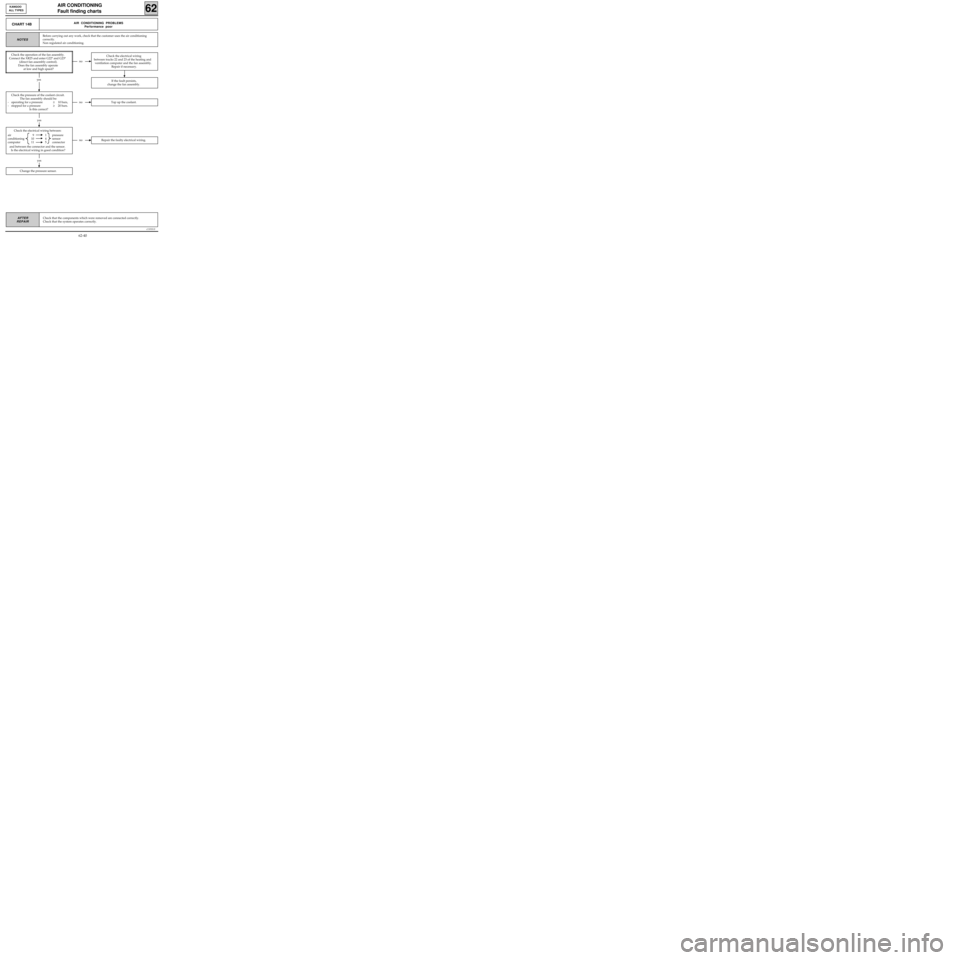
Check the electrical wiring between:
air 9 1 pressure
conditioning 10 4 sensor
computer 11 5 connector
and between the connector and the sensor.
Is the electrical wiring in good condition?
c11010.0
AIR CONDITIONING
Fault finding charts
62
KANGOO
ALL TYPES
AFTER
REPAIR
yes
CHART 14BAIR CONDITIONING PROBLEMS
Performance poor
NOTES
no
yes
noRepair the faulty electrical wiring.
yes
noTop up the coolant.
Change the pressure sensor.
Before carrying out any work, check that the customer uses the air conditioning
correctly.
Non regulated air conditioning.
Check the operation of the fan assembly.
Connect the XR25 and enter G22* and G23*
(direct fan assembly control).
Does the fan assembly operate
at low and high speed?
Check the pressure of the coolant circuit.
The fan assembly should be:
- operating for a pressure≥ 10 bars,
- stopped for a pressure≥ 20 bars.
Is this correct?
Check the electrical wiring
between tracks 22 and 23 of the heating and
ventilation computer and the fan assembly.
Repair if necessary.
If the fault persists,
change the fan assembly.
Check that the components which were removed are connected correctly.
Check that the system operates correctly.
62-40
Page 53 of 73
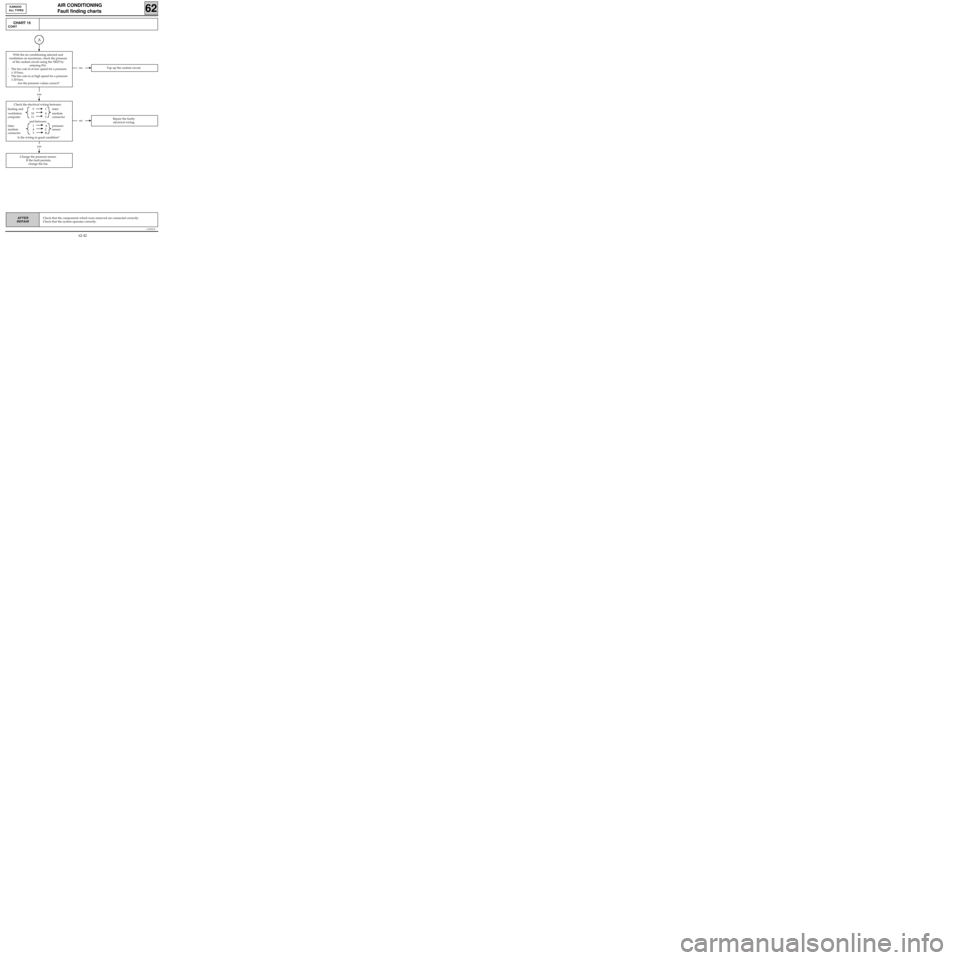
yes
Check the electrical wiring between:
heating and 9 1 inter-
ventilation 10 4 mediate
computer 11 3 connector
and between:
inter- 1 A pressure
mediate 4 C sensor
connector 3 B
Is the wiring in good condition?
c11010.0
AIR CONDITIONING
Fault finding charts
62
KANGOO
ALL TYPES
AFTER
REPAIR
CHART 15
CONT
A
noTop up the coolant circuit.
yes
noRepair the faulty
electrical wiring.
With the air conditioning selected and
ventilation on maximum, check the pressure
of the coolant circuit using the XR25 by
entering #16.
- The fan cuts in at low speed for a pressure
≥ 10 bars,
- The fan cuts in at high speed for a pressure
≥ 20 bars.
Are the pressure values correct?
Change the pressure sensor.
If the fault persists,
change the fan.
Check that the components which were removed are connected correctly.
Check that the system operates correctly.
62-42
Page 54 of 73
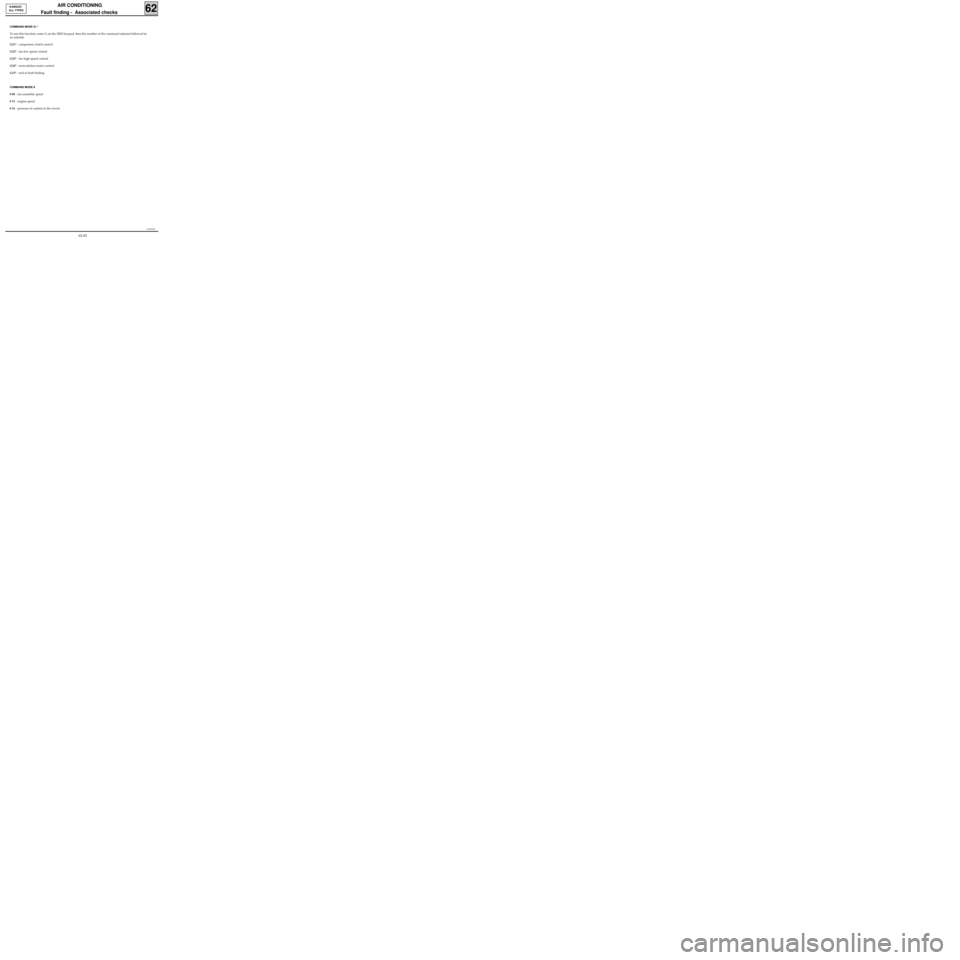
c11010.0
AIR CONDITIONING
Fault finding - Associated checks
62
KANGOO
ALL TYPES
COMMAND MODE G--*
To use this function, enter G on the XR25 keypad, then the number of the command selected followed by
an asterisk.
G21* : compressor clutch control
G22* : fan low speed control
G23* : fan high speed control
G24* : recirculation motor control
G13* : end of fault finding
COMMAND MODE #
# 08 : fan assembly speed
# 15 : engine speed
# 16 : pressure of coolant in the circuit
62-43
Page 59 of 73
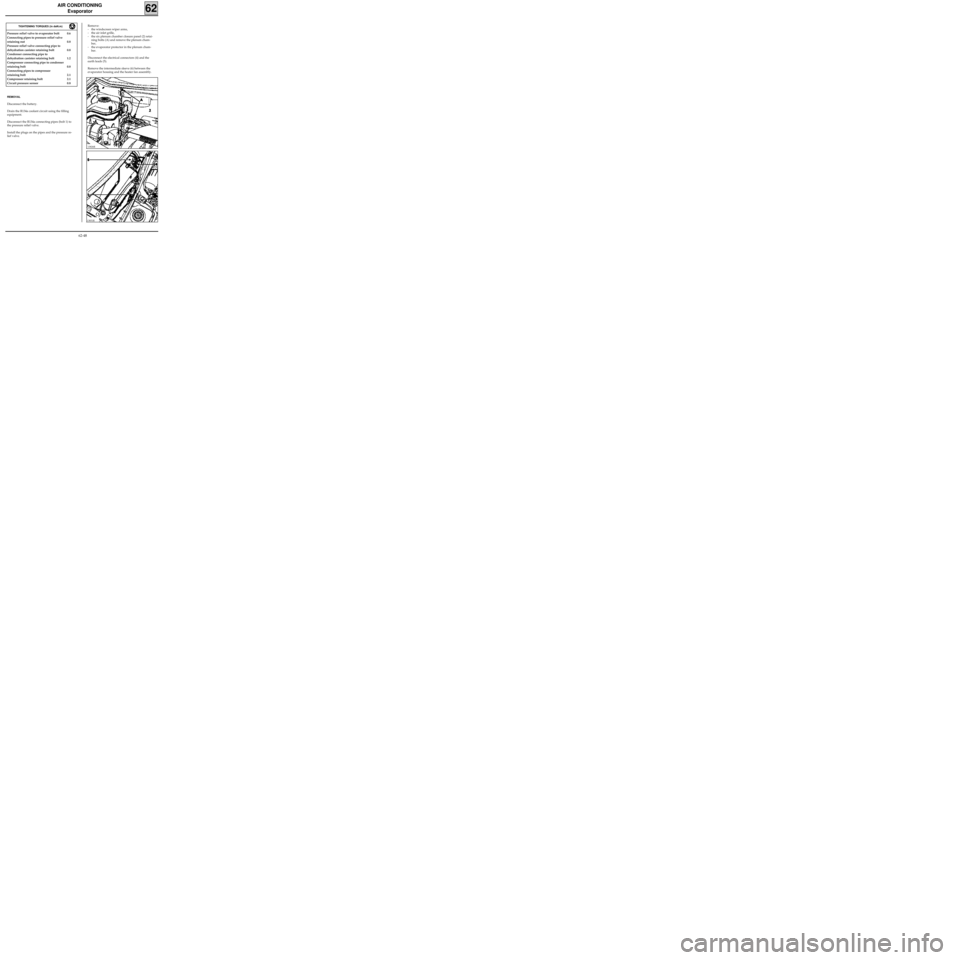
TIGHTENING TORQUES (in daN.m)
AIR CONDITIONING
Evaporator
62
13831R
Pressure relief valve to evaporator bolt 0.6
Connecting pipes to pressure relief valve
retaining nut 0.8
Pressure relief valve connecting pipe to
dehydration canister retaining bolt 0.8
Condenser connecting pipe to
dehydration canister retaining bolt 1.2
Compressor connecting pipe to condenser
retaining bolt 0.8
Connecting pipes to compressor
retaining bolt 2.1
Compressor retaining bolt 2.1
Circuit pressure sensor 0.8
REMOVAL
Disconnect the battery.
Drain the R134a coolant circuit using the filling
equipment.
Disconnect the R134a connecting pipes (bolt 1) to
the pressure relief valve.
Install the plugs on the pipes and the pressure re-
lief valve.Remove:
- the windscreen wiper arms,
- the air inlet grille,
- the six plenum chamber closure panel (2) retai-
ning bolts (A) and remove the plenum cham-
ber,
- the evaporator protector in the plenum cham-
ber.
Disconnect the electrical connectors (4) and the
earth leads (5).
Remove the intermediate sleeve (6) between the
evaporator housing and the heater fan assembly.
13826R
62-48
Page 60 of 73
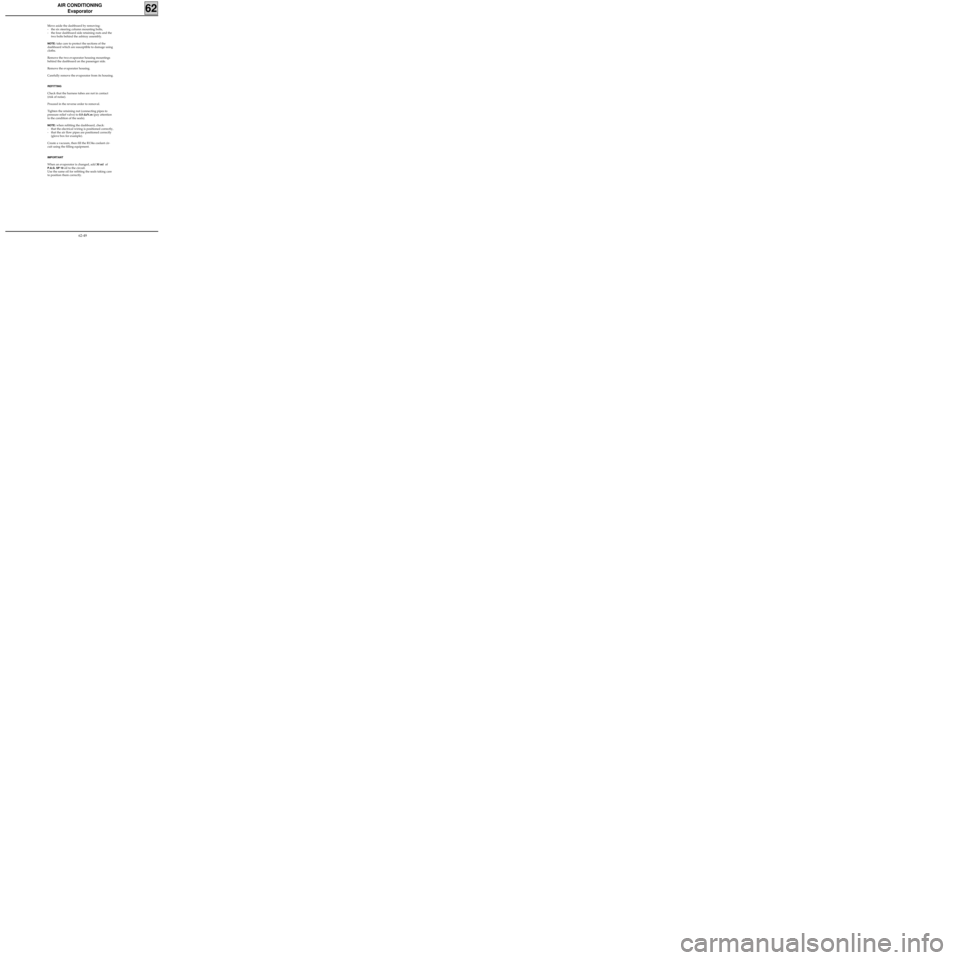
AIR CONDITIONING
Evaporator
62
Move aside the dashboard by removing:
- the six steering column mounting bolts,
- the four dashboard side retaining nuts and the
two bolts behind the ashtray assembly.
NOTE: take care to protect the sections of the
dashboard which are susceptible to damage using
cloths.
Remove the two evaporator housing mountings
behind the dashboard on the passenger side.
Remove the evaporator housing.
Carefully remove the evaporator from its housing.
REFITTING
Check that the harness tubes are not in contact
(risk of noise).
Proceed in the reverse order to removal.
Tighten the retaining nut (connecting pipes to
pressure relief valve) to 0.8 daN.m (pay attention
to the condition of the seals).
NOTE: when refitting the dashboard, check:
- that the electrical wiring is positioned correctly,
- that the air flow pipes are positioned correctly
(glove box for example).
Create a vacuum, then fill the R134a coolant cir-
cuit using the filling equipment.
IMPORTANT
When an evaporator is changed, add 30 ml of
P.A.G. SP 10 oil to the circuit.
Use the same oil for refitting the seals taking care
to position them correctly.
62-49
Page 61 of 73
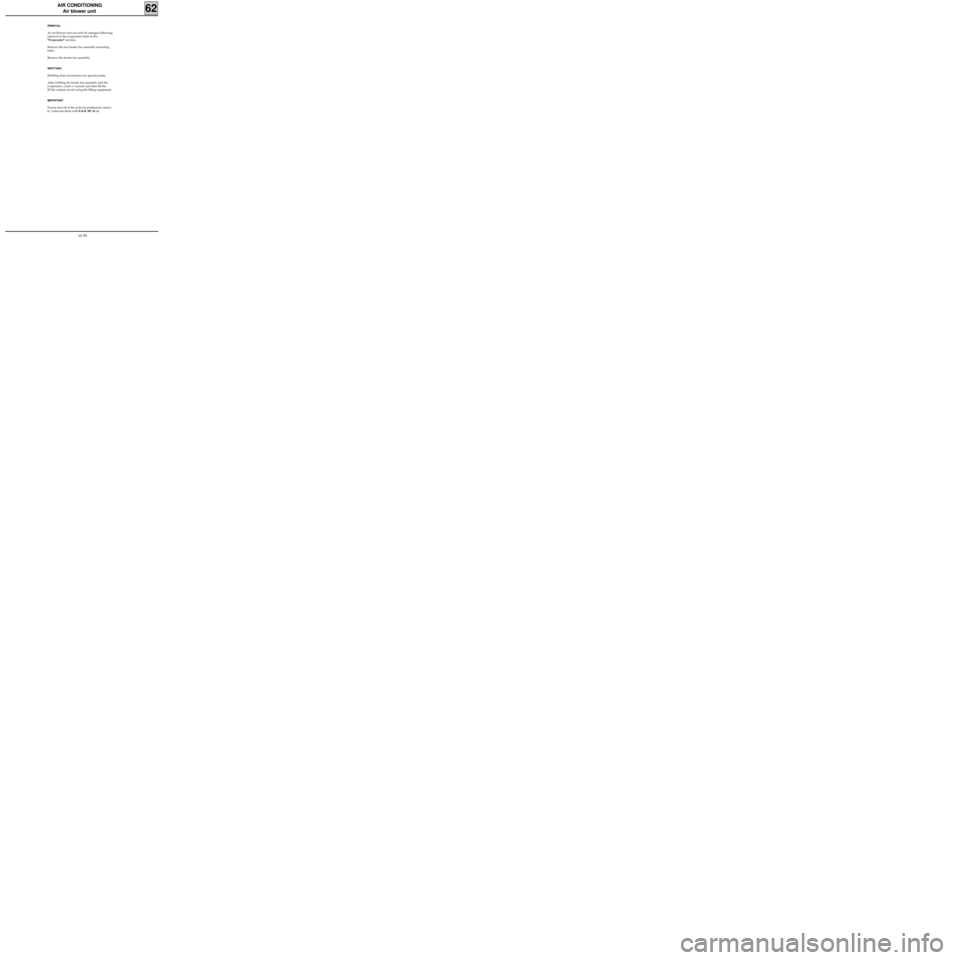
AIR CONDITIONING
Air blower unit
62
REMOVAL
An air blower unit can only be changed following
removal of the evaporator (refer to the
"Evaporator" section).
Remove the two heater fan assembly mounting
bolts.
Remove the heater fan assembly.
REFITTING
Refitting does not present any special points.
After refitting the heater fan assembly and the
evaporator, create a vacuum and then fill the
R134a coolant circuit using the filling equipment.
IMPORTANT
Ensure that all of the seals are positioned correct-
ly. Lubricate them with
P.A.G. SP 10 oil.
62-50
Page 62 of 73
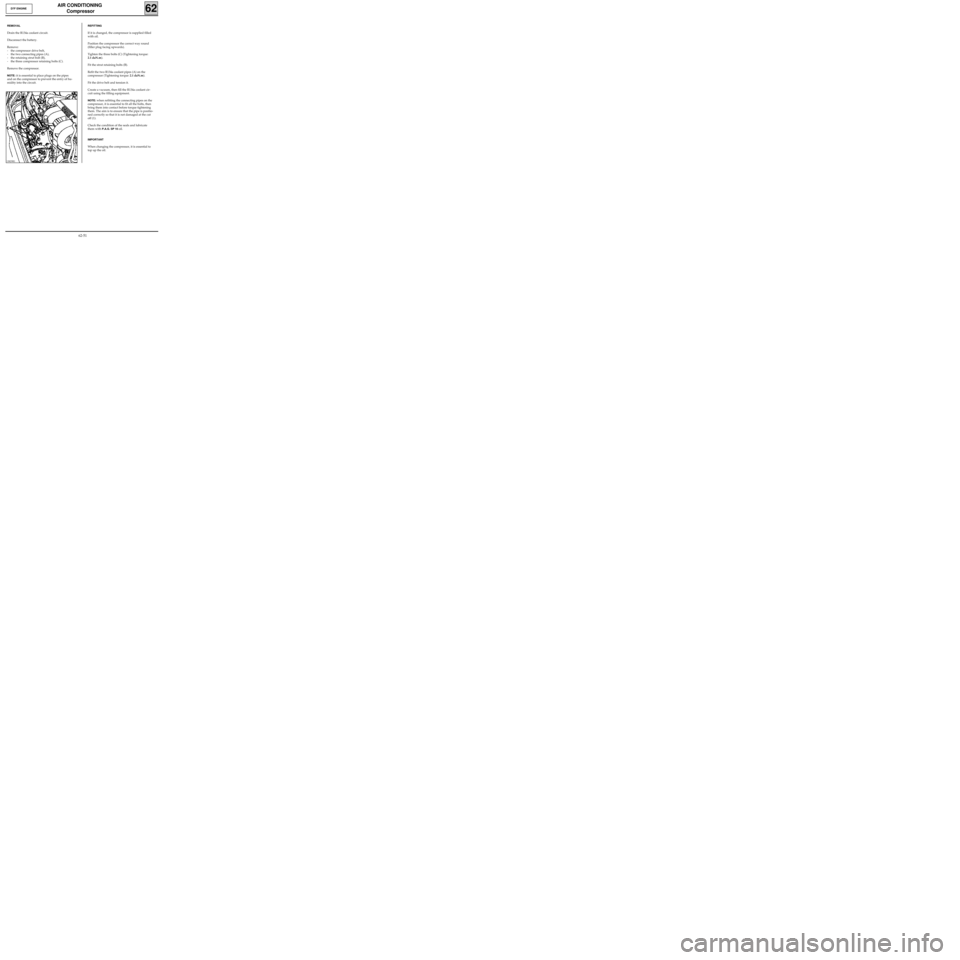
AIR CONDITIONING
Compressor
62D7F ENGINE
13829R1
REMOVAL
Drain the R134a coolant circuit.
Disconnect the battery.
Remove:
- the compressor drive belt,
- the two connecting pipes (A),
- the retaining strut bolt (B),
- the three compressor retaining bolts (C).
Remove the compressor.
NOTE: it is essential to place plugs on the pipes
and on the compressor to prevent the entry of hu-
midity into the circuit.
REFITTING
If it is changed, the compressor is supplied filled
with oil.
Position the compressor the correct way round
(filler plug facing upwards).
Tighten the three bolts (C) (Tightening torque:
2.1 daN.m).
Fit the strut retaining bolts (B).
Refit the two R134a coolant pipes (A) on the
compressor (Tightening torque:
2.1 daN.m).
Fit the drive belt and tension it.
Create a vacuum, then fill the R134a coolant cir-
cuit using the filling equipment.
NOTE: when refitting the connecting pipes on the
compressor, it is essential to fit all the bolts, then
bring them into contact before torque tightening
them. The aim is to ensure that the pipe is positio-
ned correctly so that it is not damaged at the cut
off (1).
Check the condition of the seals and lubricate
them with
P.A.G. SP 10 oil.
IMPORTANT
When changing the compressor, it is essential to
top up the oil.
62-51